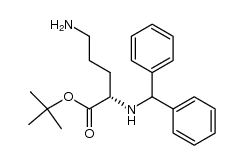L-Ornithine,hydrochloride (1:2)

L-Ornithine,hydrochloride (1:2) structure
|
Common Name | L-Ornithine,hydrochloride (1:2) | ||
|---|---|---|---|---|
| CAS Number | 6211-16-1 | Molecular Weight | 205.08300 | |
| Density | N/A | Boiling Point | 308.7ºC at 760 mmHg | |
| Molecular Formula | C5H14Cl2N2O2 | Melting Point | 197-199 °C (dec.) | |
| MSDS | Chinese USA | Flash Point | 140.5ºC | |
| Name | l-ornithine dihydrochloride |
|---|---|
| Synonym | More Synonyms |
| Boiling Point | 308.7ºC at 760 mmHg |
|---|---|
| Melting Point | 197-199 °C (dec.) |
| Molecular Formula | C5H14Cl2N2O2 |
| Molecular Weight | 205.08300 |
| Flash Point | 140.5ºC |
| Exact Mass | 204.04300 |
| PSA | 89.34000 |
| LogP | 2.14180 |
| Index of Refraction | 18 ° (C=5, H2O) |
| Safety Phrases | 26-39-36 |
|---|---|
| RIDADR | UN 1993 3/PG 3 |
| WGK Germany | 3 |
| RTECS | SP5740000 |
| HS Code | 2922499990 |
|
~% 
L-Ornithine,hyd... CAS#:6211-16-1 |
| Literature: Organic letters, , vol. 2, # 8 p. 1097 - 1100 |
|
~% 
L-Ornithine,hyd... CAS#:6211-16-1 |
| Literature: Organic letters, , vol. 2, # 8 p. 1097 - 1100 |
|
~% 
L-Ornithine,hyd... CAS#:6211-16-1 |
| Literature: Organic letters, , vol. 2, # 8 p. 1097 - 1100 |
| HS Code | 2922499990 |
|---|---|
| Summary | HS:2922499990 other amino-acids, other than those containing more than one kind of oxygen function, and their esters; salts thereof VAT:17.0% Tax rebate rate:9.0% Supervision conditions:AB(certificate of inspection for goods inward,certificate of inspection for goods outward) MFN tariff:6.5% General tariff:30.0% |
|
Increased ornithine-derived polyamines cause airway hyperresponsiveness in a mouse model of asthma.
Am. J. Respir. Cell. Mol. Biol. 48(6) , 694-702, (2013) Up-regulation of arginase contributes to airways hyperresponsiveness (AHR) in asthma by reducing L-arginine bioavailability for the nitric oxide (NO) synthase isozymes. The product of arginase activit... |
|
|
Microbacterium kyungheense sp. nov. and Microbacterium jejuense sp. nov., isolated from salty soil.
Int. J. Syst. Evol. Microbiol. 64(Pt 7) , 2267-73, (2014) Two novel strains, THG-C26(T) and THG-C31(T), were characterized using a polyphasic approach to determine their taxonomic positions. These two isolates were aerobic, Gram-stain-positive, non-motile, n... |
|
|
Treatment of arginase deficiency revisited: guanidinoacetate as a therapeutic target and biomarker for therapeutic monitoring.
Dev. Med. Child Neurol. 56(10) , 1021-4, (2014) Hyperargininaemia is a disorder of the last step of the urea cycle. It is an autosomal recessive disease caused by deficiency of liver arginase-1 and usually presents later in childhood with progressi... |
| L-Ornithine-5,5-D22HCl |
| MFCD00066571 |
| Ornithine L-form dihydrochloride |
| L-Ornithine-5,5-D2HCl |
| H-Orn-OH.2HCl |
| L-Ornithine,hydrochloride (1:2) |
| dihydrochloride of (S)-ornithine |
| Einecs 228-277-5 |
| D,L-ornithine dihydrochloride |
| L-Ornithin,Dihydrochlorid |
| Ornithine L-form HCl |
| L-Ornithine2HCl |
| L-ornithine,dihydrochloride |
| L-ornithine hydrochloride |
![1,1-dimethylethyl 4-cyano-(2S)-[(diphenylmethylene)amino]butanoate structure](https://image.chemsrc.com/caspic/077/271601-28-6.png)


 CAS#:123-75-1
CAS#:123-75-1